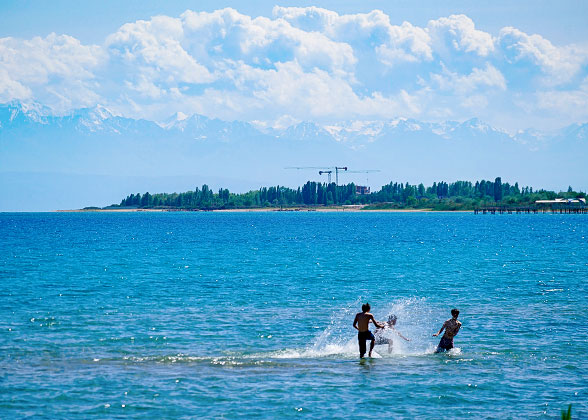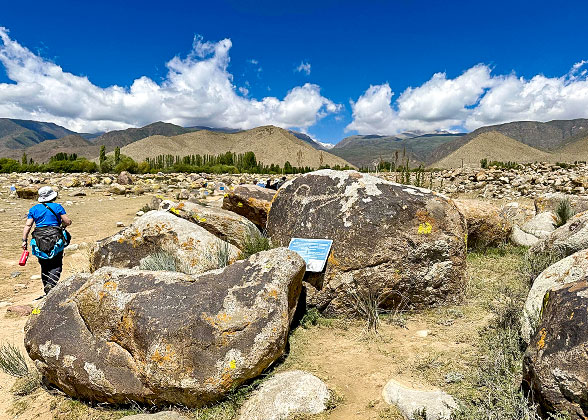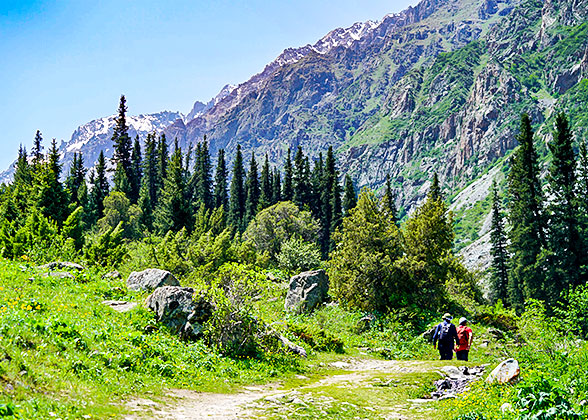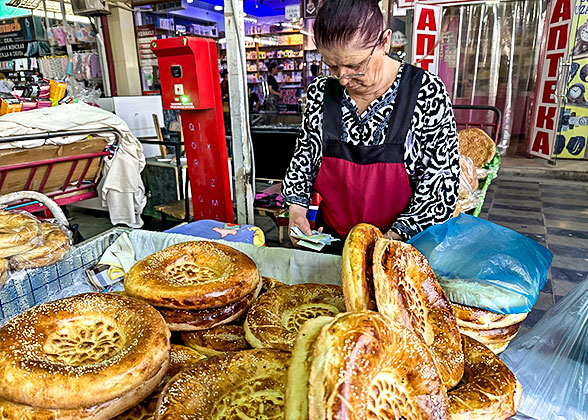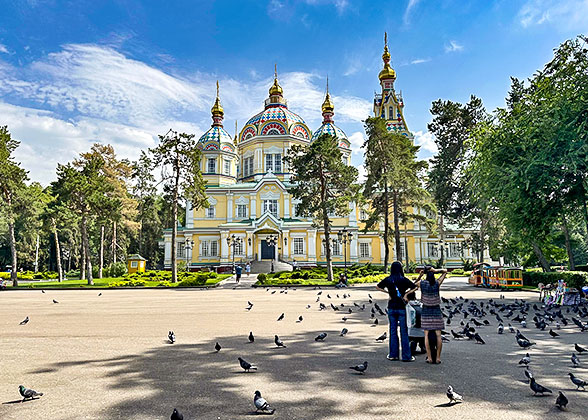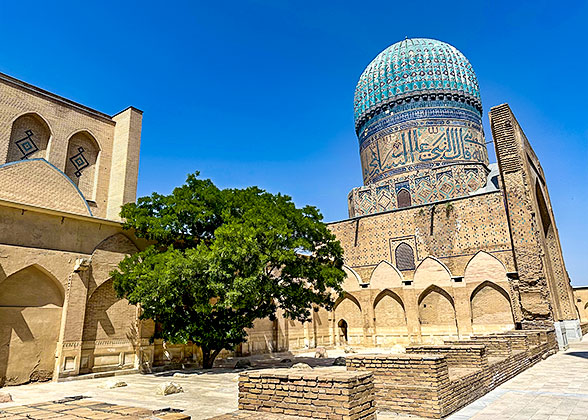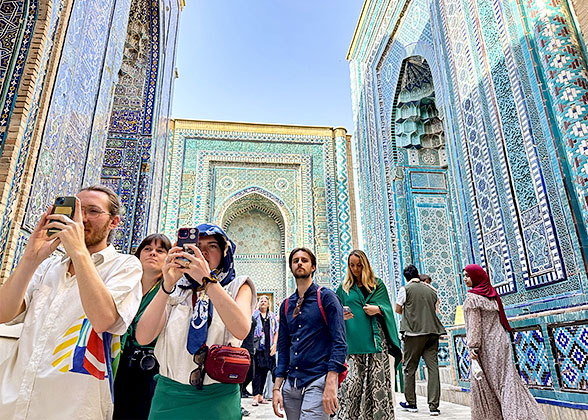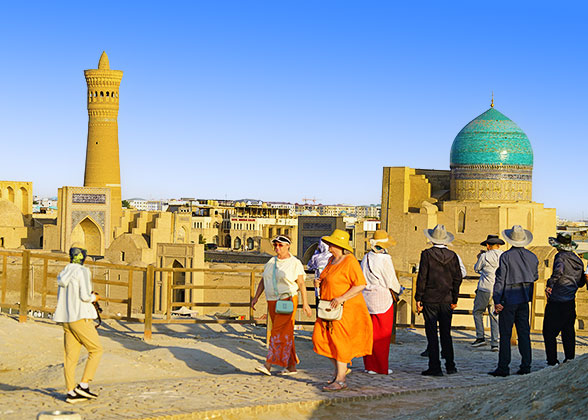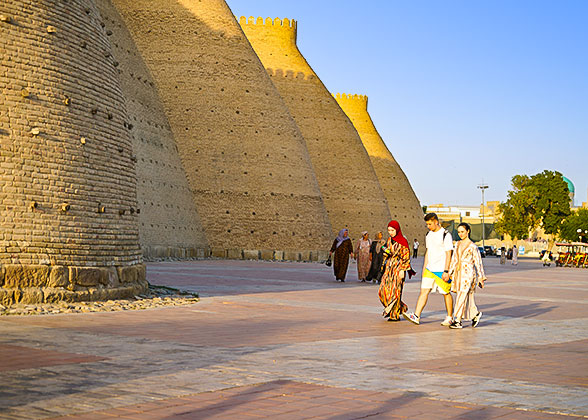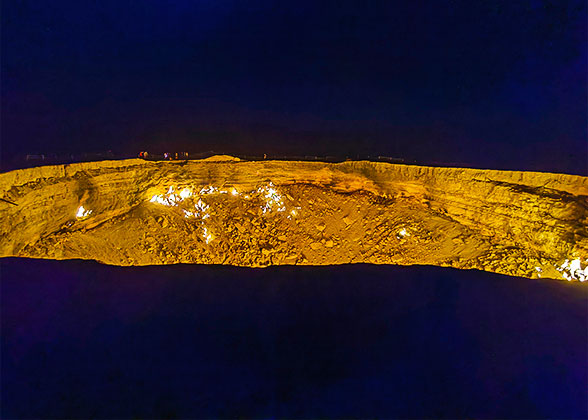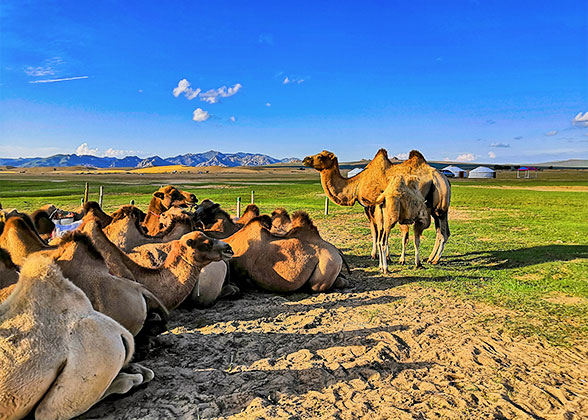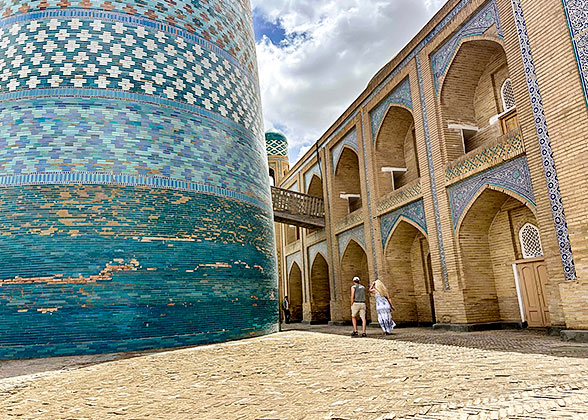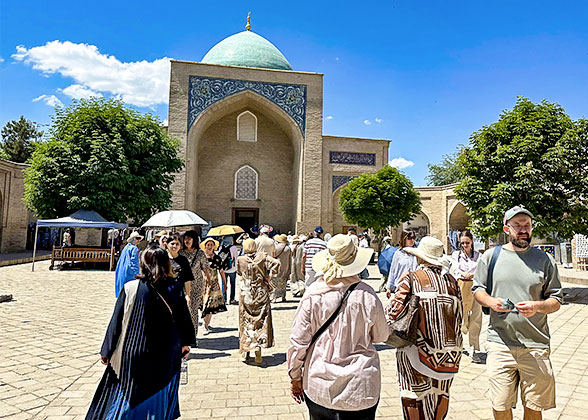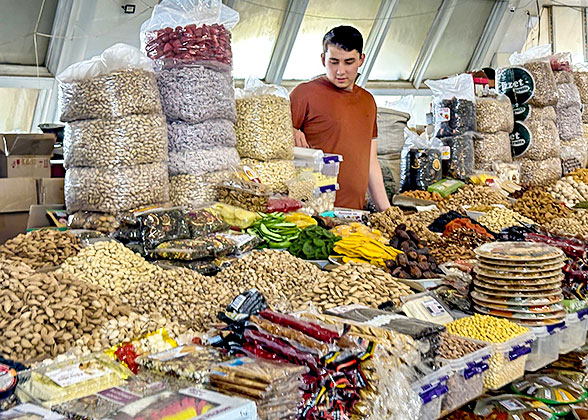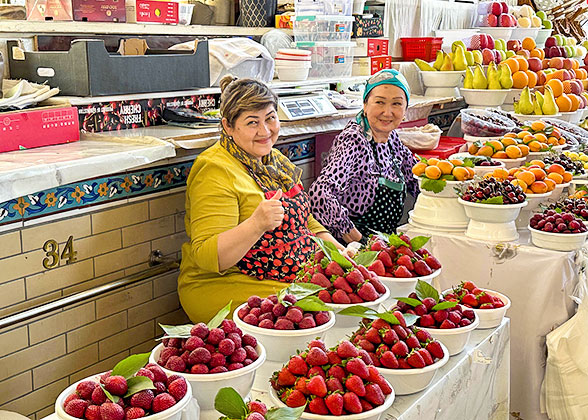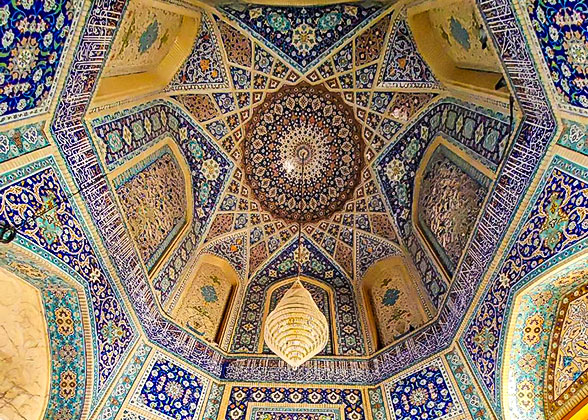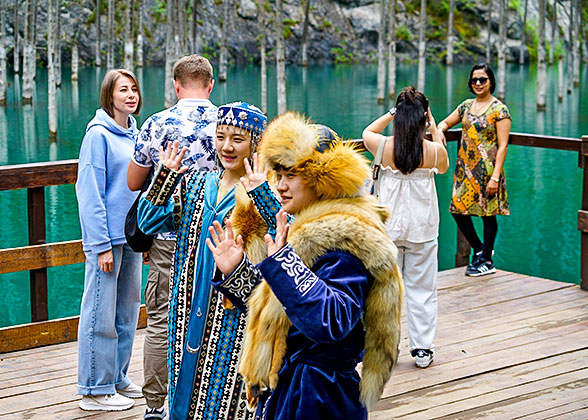Day 1: Arrival in Kyrgyzstan, Bishkek Airport Pick-up
Welcome to embark on our legendary five Stans tour through the heart of Central Asia! Let’s explore Kyrgyzstan first, where alpine grasslands, azure lakes, and traditions of the nomadic lifestyle will whirl your imagination. Our guide and the driver will meet you at Bishkek International Airport and escort you to the hotel. Once you are revitalized, it’s time to hit the road! Your visit will begin with Bishkek’s iconic landmarks of Old Square, Oak Park, and Ala-Too Square, where you can appreciate statues of Kyrgyzstan’s national hero, Manas, and the only female leader in Central Asia, Kurmanjan. Before returning to the hotel, we will stop by the National Opera and Ballet Theatre of Abdylas Maldybayev and take photos from the outside, feasting your eyes on those intricate neoclassical carvings. ★ Why Choose Us for Your Central Asia Exploration?1. While Kyrgyzstan, Kazakhstan, and Tajikistan allow visa-free travel, visiting Turkmenistan requires both a tourist visa and a letter of invitation from the authorities. Don’t worry! We’ll arrange it for you, so you can explore Central Asia seamlessly. 2. With challenging road conditions and limited signal coverage, self-driving in Central Asia can be tough; however, our experienced drivers specialize in this, allowing you to soak up the stunning views worry-free when traversing different landscapes. In addition, as English is not widely spoken in Central Asia, our private English-speaking guide will enrich your experience with thorough insights about each attraction. ► Things to Know: 1. Currency: Bring US dollars to travel, as they can be easily exchanged into local currency across Central Asia, and prepare small denominations for immigration fees and visa fees. 2. Clothing: Dress in layers to cope with changing climates in different landscapes, from high mountains to hot deserts, and wear your most comfortable flats or climbing shoes for hiking. If you visit between June and August, protect yourself from the strong sun rays and replenish water in time. Accommodation: Ramada by Wyndham Bishkek Centre Hotel (4 stars) or similar
|
Day 2: Bishkek - Burana Tower - Issyk-Kul Lake (Cholpon Ata)
After breakfast, drive to Burana Tower, a landmark building along the ancient Silk Road built in the 9th century. Climb to its top to overlook the majestic Tian Shan Mountains and the ruins of Balasagun. If heights aren’t your thing, enjoy nearby petroglyphs instead. Next, we’ll embark on a 4-hour scenic drive to Issyk-Kul Lake, the world’s second-largest mountain lake. Sitting at an altitude of 1,600 meters (5,249 ft.), this lake never freezes, hence its name Issyk-Kul, meaning ‘Warm Lake’ in Kyrgyz. It resembles a vast blue jade embedded amidst mountains, with the surface rippling with waves and flanked by extensive grasslands. On the way, admire the snow-capped peaks along the northern shore and the lush forests to the south. We’ll also stop by the Nomad Museum, designed to reflect traditional yurt lifestyle, including essential artifacts like national costumes, traditional saddles, and equestrian gear. After arriving at Cholpon Ata and checking into the hotel, enjoy some free time by yourself! This region offers one of the most stunning views of the Issyk-Kul Lake, and you can unwind by the beach, enjoy a sunbath, or try a soothing blue mud spa. For adrenaline junkies, why not ride a paraglider to overlook the lake’s eye-like shape? In summer, you can also cruise into the heart of the lake and take a refreshing dip! Meals: Breakfast
Accommodation: Kapriz Issyk Kul Resort, Cholpon Ata (3 stars) or similar
|
Day 3: Cholpon Ata - Karakol - Tamga, Skazka Canyon Discovery
In the morning, the guide will escort you to visit the open-air Museum of Petroglyphs to witness the vivid scenes of hunting and daily life from 2,000 years ago. Then drive along the north bank of Issyk-Kul Lake to the biggest city in the area, Karakol. You’ll be accompanied to visit Holy Trinity Cathedral, a Russian Orthodox Church featuring an iconic golden onion-shaped dome and emerald green-roofed towers, and Dungan Mosque, built by Dungan people who emigrated from northwestern China, as you can tell from the typical Chinese-style upturned eaves of the temple. Next, drive to Tamga on the south bank of Issyk-Kul Lake. After checking into a comfortable yurt, let’s explore Skazka Canyon (Canyon Fairy Tale), which is filled with bizarre burnt-orange rock formations sculptured by water and wind erosion, resembling everything from mythical creatures to the Great Wall of China. The view from the observation deck is remarkable, especially during sunset when the colors are more saturated. Since we’ll hike through the canyon, please wear climbing shoes, as the trail can be steep and slippery! Meals: Breakfast, Dinner
Accommodation: Nomad Lodge Tamga
|
Day 4: Tamga - Bokonbayevo (Eagle Hunting) - Bishkek; Fly to Almaty of Kazakhstan
★ Witness Kyrgyzstan’s Centuries-old Tradition of Eagle HuntingIn the morning, take a 1-hour drive to Bokonbayevo Village, where skilled eagle trainers will share their stories about raising golden eagles. Golden eagle hunting has been important for Kyrgyz people to get food in vast grasslands and mountain ranges since the 12th to 13th century, evolving into a cultural heritage and sport that showcases the bird’s skill. Why would those proud creatures like to serve nomads? A novice falconer will spend 3 to 4 years cultivating trust with a baby eagle, during which the bird learns to recognize its owner’s voice and different commands. As the eagle matures, it is asked to smell the animal fur to be familiar with the scent of prey. With vision eight times sharper than ours, the golden eagle can quickly spot the target and capture it with their formidable claws through long-term flying training. After serving its human counterpart for 15 years, it will be released back to the wild. After exploring a local bazaar, we’ll drive 5 hours back to Bishkek Airport, where you’ll catch a flight to Almaty, Kazakhstan. After landing, the local driver-guide will send you to the hotel. Tomorrow, prepare for another exciting experience with stunning snow-capped mountains and the metropolis of this world’s largest landlocked country!  Please Note: While exploring Kazakhstan, please smoke only in designated zones, even in outdoor public areas such as parks; otherwise, it may lead to a hefty fine of KZT 42,000 (USD 85), which also applies to electronic cigarettes. Meals: Breakfast
Accommodation: Renion Park Almaty (4 stars) or similar
|
Day 5: Almaty: Central Mosque, Green Bazaar, Ascension Cathedral, Central Mosque, Kok-Tobe Hill
Meet with our driver-guide at the hotel lobby, and head to today’s first stop, Central Mosque. Built in 1890, it is the second-largest mosque in Kazakhstan. Look at the simple but elegant mosque with five minarets, the tallest of which is 47 meters (155 feet), and the 36-meter-high (120 feet) central dome. Observing from the inside, the dome is decorated with colorful mosaics, inlaid with religious texts from the Koran written by famous Turkish calligraphers. Next, ramble along the avenue of Park of 28 Panfilov Guardsmen to admire the remarkable Ascension Cathedral (Zenkov Cathedral), the world’s second-tallest wooden church with a height of 56 meters (184 feet). Then, move southward to Green Bazaar (Zeleny Bazaar), a microcosm of Almaty’s multi-ethnic culture and daily life. Before exploration, you can get some cash ready at the exchange point with a green sign, which is said to be the most competitive one in the city, with about USD 1≈KZT 500. Wandering through different stalls, you may encounter Uzbek vendors inviting you to savor sweet dried fruits, Tajik sellers arranging huge melons, and Koreans proudly offering their pickles, while the Kazak shopkeepers remind you of the region’s nomadic traditions with their beloved horse meat and various cheese products. Getting out of the market, the driver-guide will transfer you to the Medeu Gorge located in the outskirts of Almaty. Let’s take a cable car to the world’s highest ice skating rink, Shymbulak Ski Resort Area. As you ascend, get ready to be awed by the breathtaking panoramic view of the valley and snow-capped Heavenly Mountains in the distance. Then, return to the city area and conclude our visit with a stunning sunset at Kok-Tobe Hill and enjoy an enchanting descent on a cable car to wash away your fatigue when the golden sunlight reflects off the glass window. Finally, you’ll be escorted to the hotel. Meals: Breakfast
Accommodation: Renion Park Almaty (4 stars) or similar
|
Day 6: Fly from Almaty to Dushanbe, Tajikistan: Visit National Museum & Victory Park
After breakfast, you’ll be sent to Almaty airport for a 2-hour flight to Dushanbe, the capital of Tajikistan. With 93% of its territory covered by mountains, Tajikistan is truly an adventurer’s paradise! Upon arrival, our local guide and the driver will whisk you to the hotel. After a traditional lunch, we are going to visit the National Museum, which houses artifacts from the ancient sites of Panjakent, Sarazm, and Khujand, dating from the 4th century BC to the 20th century, including ceramics, tools, sculptures, and jewelry. The museum’s highlight is the 13-meter (43-foot) long statue of “Buddha in Nirvana”, one of the largest Buddha statues found in Central Asia. You can also admire the fragments of Chinese silk paintings nestled beneath the Buddha’s head. Next, escape into the Botanical Garden and embrace lush greenery. Locals often hold parties or weddings there, and if lucky, you may witness a joyful celebration. Finally, we’ll have panoramic views of Dushanbe in Victory Park from the mountaintop and appreciate the nearby plaque to commemorate the heroes of WWII. ► Why do Countries in Central Asia Have the “Stan” Suffix? This suffix originates from Old Persian, initially representing a vast area and evolving to indicate places inhabited by a specific ethnic group until today. The five-stan countries of Central Asia, once a part of or deeply influenced by the Persian Empire (550-330 BC), adopted this naming convention while maintaining their identities to the predominant ethnic culture, so they named their countries after the main ethnic group plus stan after gaining independence from the Soviet Union. For example, Tajikistan means the ‘land of the Tajiks’. Meals: Breakfast
Accommodation: Hotel Atlas Dushanbe (4 stars) or similar
|
Day 7: Drive 8 Hours from Dushanbe to Kalai-Khumb along Pamir Highway
★ Legendary Pamir Highway Adventure through “Roof of the World”Today marks the most exhilarating chapter of your Tajikistan journey with a legendary road trip across the Pamir Plateau! Spanning Tajikistan, China, and Afghanistan, this high-altitude region features some of the world’s most dramatic mountain ranges, like the Himalayas, the Heavenly Mountains, and the Kunlun Mountains, all towering over 5,500 meters (18,045 ft.) high, thus dubbed the “Roof of the World”. But those huge mountains didn’t block exchanges between the East and West; instead, they witnessed countless caravans carrying goods along the ancient Silk Road. Following those great explorers, we’ll drive along the M41 Pamir Highway to Kalai-Khumb for 8 hours and stop by the Nurek Reservoir to marvel at its turquoise water encircled by rugged mountains. When arriving at the Shuraba Pass at an elevation of 2,267 meters (7,438 feet), you’ll see the Panj River winding through the valley, with towering cliffs on the left and the opposite Afghan village with many quaint mud-walled houses on the right. You may also spot local villagers zipping by on motorcycles! Upon arrival at Kalai-Khumb, check into the hotel and ensure a good rest to refuel for tomorrow’s road adventure. ► Important Tips: 1. Although entering Tajikistan is visa-free, visiting the Pamir region requires a GBAO permit. The easiest way to get this is by selecting the GBAO license option when applying for an e-visa, even though you may not need a visa. For reference, the total cost is USD 109. There are several checkpoints on the way, and you can prepare multiple copies of your passport information page and GBAO permit in advance for smooth passage. 2. Given the long journey time, changing altitudes, and poor road conditions, please pack motion sickness pills, painkillers, and portable oxygen cylinders just in case. Meals: Breakfast
Accommodation: Karon Palace Hotel, Kalai-Khumb (4 stars) or similar
|
Day 8: Drive 7 Hours back to Dushanbe
Today, we’ll say goodbye to the Pamir region and return to Dushanbe with a 7-hour drive along the northern route of the Pamir Highway. Although the journey is a bit shorter than yesterday’s, it is more challenging due to poor road conditions. But hold on, the magic lies ahead! The surrounding snow-capped mountains and valleys offer staggering rewards. We’ll traverse through Khaburabot Pass at an altitude of 3,252m (10,669 ft.), where the road narrows with sheer cliffs and no guardrails. It’s a thrilling adventure, but trust our driver’s superb skills and soak up the ethereal sights with the sunlight cascading over the majestic peaks! After arrival at Dushanbe, you’ll be transferred to the hotel. Meals: Breakfast
Accommodation: Hotel Atlas Dushanbe (4 stars) or similar
|
Day 9: Drive 5 Hours from Dushanbe to Panjakent, Transfer to Samarkand, Uzbekistan
Make our way to Panjakent for about a 5-hour drive after breakfast. Today’s sightseeing will begin at the Republican Museum of History and Local Lore of Rudaki, home to various Tajik ethnic costumes, intricate embroideries, bronze vessels, and murals unearthed at the ruins of ancient Panjakent. Then a local bazaar exploration awaits. After that, we’ll head to the Ancient Town of Panjakent. The city once thrived as the cultural and trade hub of the Sogdian civilization from the 5th to the 8th century, with prosperous markets and magnificent residences, and was thus also called “Pompeii of Central Asia”. You’ll marvel at extraordinary murals, despite being 1,500 years old, which vividly depict the universe, religious rituals, and scenes of hunting and battle. Our next stop is the ancient city of Sarazm, where the tomb of a princess was discovered, adorned with an array of stunning jewelry, including rare shells from the Arabian Sea and gold bracelets from Indian civilization. After that, drive to the Uzbekistan border and meet your Uzbek driver, who will transfer you to the hotel in Samarkand. Located in the heart of the ancient Silk Road, Uzbekistan has been a vital trading hub for merchants traveling to Eastern Asia, the Arab Empire, and Europe. Throughout its over 5,000 years of history, numerous stunning buildings and artistic achievements have emerged, which you’ll explore one by one in the following days with our guide.  Visa Tip: Visitors from the US and 50 other countries must obtain an e-visa to enter Uzbekistan; however, those American passport holders under 15 or over 55 can enter visa-free. Given that we will traverse the Uzbek border twice in this itinerary, you can apply for a double-entry visa for USD 35. Meals: Breakfast
Accommodation: Grand Samarkand Superior (4 stars) or similar
|
Day 10: Samarkand: Registan Square, Bibi Khanym Mosque, Siyob Bazaar, Gur-Emir Mausoleum
Today is dedicated to exploring Samarkand, whose history dates back to the 7th century BC, parallel to the great civilizations of ancient Rome, Athens, and Babylon. Legend has it that when Alexander the Great conquered this magnificent city, he was so awestruck by its splendor that he exclaimed, “Everything I heard about Samarkand is true, except that it’s more beautiful than I ever imagined.” Our first stop is the iconic Registan Square, the city’s center, consisting of the Ulugh Beg Madrasah, Shir Dor Madrasah, and Tilya Kori Madrasah. The intricate geometric designs and Arabic calligraphy inscribed on the walls will sweep you into the heart of Islamic artistry, while the striking blue hues capture the essence of Samarkand’s architecture, representing heaven and purity in Islamic culture. Bibi Khanym Mosque, Samarkand Shah-i-Zinda Necropolis, Samarkand
Next, let’s head to the Bibi Khanym Mosque, which features a vast blue dome and ornate decorations, named in honor of the wife of Timur, the founder of the Timurid Empire (1370-1507). Prepare to be moved as our guide shares the poignant love story behind its creation. Afterward, dive into the nearby Siyob Bazaar, brimming with exotic goods that traversed the ancient Silk Road, like fragrant spices and succulent fruits. You can also try various local snacks by yourself, like Lagman, chewy noodles drenched in a rich sauce of lamb, onions, carrots, and peppers, or Qurt, a dairy product made from marinated yogurt, tasting slightly salty and sour. Following that, make our way to Ulugbek Observatory, an important site that propelled Islamic astronomy into a Golden Age. Before returning to the hotel, we’ll visit the Gur-Emir Mausoleum and Shah-i-Zinda Necropolis, which are the final resting places of Timur and his family. Lose yourself in the splendid beauty of their interior ceilings adorned with blue, yellow, and green mosaics, resembling a starry sky. Meals: Breakfast
Accommodation: Grand Samarkand Superior (4 stars) or similar
|
Day 11: Take a High-speed Train from Samarkand to Bukhara
After breakfast, you’ll be escorted to the railway station for a 2-hour high-speed train to Bukhara. Upon arrival, you’ll be transferred to the hotel for check-in, and the remainder of the day is left for your free exploration. Bukhara is a living museum with a history of over 2,500 years, during which it once served as the capital of the Samanid Dynasty (819-999) and was conquered by Genghis Khan and Timur in the Middle Ages. It is said that stories of the One Thousand and One Nights also originated here. While Samarkand shimmers in vibrant blues, Bukhara’s earthy hues will evoke the simple yet profound beauty of the Silk Road era. ► Activities & Dinner Suggestion (at your own expense): Beyond the historic landmarks, the ancient Silk Road leaves many trading domes in Bukhara that are now hubs for handicrafts enthusiasts. After a short rest, you can visit Toki Tim Abdullah Khan, Toki Zargaron, and Toki Telpak Furushon to check out suzani embroidery, blue-green glazed pottery, and miniature paintings. Remember to bargain with the vendor to get a 30%-50% discount! As the night winds down, consider having dinner at the Ayvan Restaurant with a fabulous terrace, which is open until 22:30. Be sure to try their signature dish, Grilled Beef Ribs, which are stewed before grilling, making them tender with a smoky flavor. Creamy Mushroom Noodles and Grilled Veggies are ideal vegetarian options. Since the restaurant is quite popular, grab your table online in advance! Average Cost per Person: UZS 200,000-250,000 (USD 15-20) Address: N. Husainova 7 Hotel Lyabi House, Bukhara 200100, Uzbekistan Meals: Breakfast
Accommodation: Volida Hotel Bukhara (3 stars) or similar
|
Day 12: Bukhara: Samanid Mausoleum, Bolo Hauz Mosque, Kalyan Minaret, Lyabi Hauz Ensemble
Today, our guide will lead you on a walking tour of Old Bukhara, starting at the Samanid Mausoleum. Despite the small size, the mausoleum near Bukhara Central Market features an exquisite structure, and you’ll marvel at how the architects skillfully stacked bricks in 22 ways, presenting geometric patterns and hollowed designs that reflect universal harmony. Next, we’ll visit the Chashma Ayub Mausoleum, built to honor the famed Jewish prophet. According to the legend, he possessed a magical scepter, striking the ground and creating a spring that flowed into Bukhara. Then move to the Bolo Hauz Mosque, distinguished by 20 exquisitely carved columns. Squatting beside them and gazing upward, you’ll be attracted by the kaleidoscope effects of complex stalactite units in star shapes. Facing it is the Ark Fortress, an ancient settlement dating back to the 5th century. After that, continue visiting the Kalyan Mosque and Kalyan Minaret. During Genghis Khan’s 12th-century expedition, he was so impressed by the latter that he ordered it to be spared when his army destroyed its surroundings. Kalyan Minaret, Bukhara Ark Fortress, Bukhara
Afterward, we’ll head to the Magoki-Attori Mosque, a hidden gem that was once buried 6 meters (20 feet) underground until its discovery in the 18th century, now transformed into a small carpet museum. Continue our visit to the Ulugh Beg Madrassah, named after Timur’s grandson, who is a revered astronomer and developed Samarkand and Bukhara into a cultural and study center of Central Asia. It’s no surprise that astral designs are all over the madrasah’s decorations! Follow our guide to the opposite Abdulaziz Khan Madrassah, and you’ll find its walls embellished with Chinese dragons and the Semurg bird, a symbol of spiritual awakening in Persian myths, instead of geometric elements. The Lyabi Hauz Ensemble is our last stop today, the best place to observe local life at its central square. A large pond sparkles in the sun, with fountains sprinkling graceful arcs in the air, and residents happily chatting or enjoying coffee and ice cream around it. Finally, you’ll be escorted back to the hotel. Meals: Breakfast
Accommodation: Volida Hotel Bukhara (3 stars) or similar
|
Day 13: Side Trip from Bukhara: Chor-Minor Madrasah and Summer Palace, Gijduvan’s Pottery House
After breakfast, let’s set off to the well-known Chor-Minor Madrasah. Chor Minor literally means “four minarets”, whose appearance resembles more of an Indian tomb than a traditional madrasah, with each minaret symbolizing Zoroastrianism, Islam, Christianity, and Buddhism. It has also graced the cover of Lonely Planet, making it a must-see sight in Uzbekistan, even if it requires navigating through some unassuming alleys. Then we’ll proceed to the Summer Palace (Sitorai Mokhi-Khosa Palace), the former residence of Bukhara’s last ruler, which provides a glimpse of the aristocrats’ lifestyle through its splendid domes, relief patterns framed by golden lines, and sunlight rooms filled with delicate porcelain. You might even spot some peacocks strolling among the structures. In the afternoon, travel to Gijduvan town to visit Abdulla Narzullaev’s Pottery House. Abdulla, who has been honored with the title of People’s Master of Uzbekistan, regards clay as the essence of his life. Our guide will invite you to sip a cup of tea while observing how raw materials turn into stunning artworks. Finally, we’ll drive back to Bukhara. Meals: Breakfast
Accommodation: Volida Hotel Bukhara (3 stars) or similar
|
Day 14: Bukhara - Turkmenistan Border - Mary
Today, the driver will transfer you to the Turkmenistan border. You’ll need to pay the Turkmenistan visa fee at customs, ranging from USD 50 to 150 depending on your nationality, along with a USD 10 immigration tax and a USD 4 bank fee, all payable in cash. Due to thorough border checks, this crossing would take some extra time, so ensure you bring some snacks before leaving Bukhara. After completing customs, you’ll be picked up by the Turkmenistan guide with the driver and sent to the hotel in Mary. Welcome to Turkmenistan! This is one of the world’s least explored countries, known for its strong centralization and strict visa policies. With our provided letter of invitation, your journey will be simple. Just follow our guide to dive into the rich history of ancient Silk Road City ruins, marvel at the surreal white marble landscape of the capital, and traverse vast deserts that cover 80% of the country!  Tip: Internet access in Turkmenistan is highly regulated and often limited to 3G connectivity, affecting phone calls and social media app usage. To stay connected with your family, consider purchasing a local VPN or SIM card, but prepare for potentially slow internet speeds. For reference, a SIM card with a 2GB data package may exceed USD 50. Meals: Breakfast
Accommodation: Mary Hotel (4 stars) or similar
|
Day 15: Mary: Ancient Merv, Mary Regional Museum; Fly to Ashgabat
After breakfast, our guide and the driver will lead you to the best-preserved city along the ancient Silk Road, Ancient Merv. Once the leading city of the Islamic world at its zenith during the Seljuk Empire (1037-1194), Ancient Merv was characterized by a network of canals and bridges amidst numerous gardens and orchards. The city also housed more than 10 libraries, drawing scholars from around the globe to study and share knowledge. Although much of the city was devastated by the Mongol invasion in the 13th century, remnants of ancient walls, mosques, and mausoleums provide a window into its past splendor. In the Ancient Merv State Historical and Cultural Park, we’ll first explore the Great Kyz Kala and Little Kyz Kala, two ancient fortresses. The Great Kyz Kala is still in good shape, featuring at least ten rooms said to be the guards’ dormitories. Even though the Little Kyz Kala has suffered severe damage, you can still see its main outline from the east side. Continue onward to the Askhab Mausoleums, where the two earliest companions of the Prophet Muhammad are remembered and honored by many pilgrims to this day. After overlooking the site from its highest point at Erk Kala, let’s check out the Sultan Sanjar Mausoleum, notable for its 5-meter (16-foot) thick walls that endured the assaults of the Mongol Army in the 13th century, making it the best-preserved building in the ruins. Next, we’ll drive back to Mary to visit the Mary Regional Museum. In the Archaeological Hall, learn more about the daily lives of ancient Merv through fascinating artifacts like seals and a cosmetic spoon. Also, you can step into the yurt in the Ethnography Hall to experience traditional nomadic life. After that, you’ll be whisked away to the airport for a 40-minute flight to Ashgabat, which might be replaced by a 4-hour drive depending on the flight schedule. Upon arrival, you’ll be picked up and transferred to the hotel. Meals: Breakfast
Accommodation: Sport Hotel Ashgabat (4 stars) or similar
|
Day 16: Ashgabat: Ertugrul Gazi Mosque, Horse Stable, Fortresses of Nisa, National History Museum
Today is all about Ashgabat, and our first stop is the Ertugrul Gazi Mosque, a spiritual site designed in Turkish style. Its gleaming white marble facade integrates harmoniously with the Ashgabat skyline, dotted with blue elements that pay homage to the Blue Mosque in Istanbul, reflecting the shared Islamic beliefs. Then our guide will walk you through Independence Park, where an iconic monument stands on its axis to symbolize Turkmenistan’s devotion to neutrality and peace. Afterward, head to the Arch of Neutrality, a tripod-shaped structure whose columns represent neutrality, independence, and national unity. No trip to Turkmenistan would be complete without admiring its national treasure, the Akhal-Teke horses, and we’ll then visit the horse stable to learn more about them. It is said that their skin turns red, looking as if they’re bleeding, when running under the sun because of the well-developed network of capillaries and thin skin. You would have a chance to talk with the owner to discover the truth, and if you like, have a hands-on riding experience at your own expense. Our next stop is the Parthian Fortresses of Nisa, constructed from earth and wood and serving as the former royal palace of the Parthian Empire (247 BC-224 AD). Severely damaged during the 1948 Ashgabat earthquake, the site now looks like several obscure mounds. The northern building complex was the royal wine and jewelry warehouse, and the excavated rhytons, ivory drinking vessels engraved with images of Greek deities, imply the region’s ancient Greek and Roman influences. You’ll view them at our last stop, the National History Museum, where you can also appreciate items from early agricultural civilizations, such as flint tools and clay and metal products. Finally, you’ll return to the hotel for rest. Meals: Breakfast
Accommodation: Sport Hotel Ashgabat (4 stars) or similar
|
Day 17: Drive from Ashgabat to Darvaza Gas Crater, Stop by Erbent Desert Community
After breakfast, a 4WD vehicle will be arranged for you to enjoy an exciting 4-hour journey through the Karakum Desert to see the legendary Darvaza Gas Crater. On the way, wear earphones and soak up the desert’s rugged beauty to relieve motion sickness. We’ll stop by the Erbent desert community to gain insights into the area’s nomadic tradition. Upon arrival, prepare to see three craters: one filled with water, another with bubbling mud, and the last, the famous Door to Hell, where the mesmerizing blaze dances in a pit that measures 70 meters (230 feet) in diameter and 25 meters (82 feet) deep. It was formed by soil collapse during a gas drilling incident in 1971. To reduce the potential dangers of leaking gas, Soviet geologists ignited it, believing it would burn out over time. While the flames still burn today, they have significantly diminished, so seize the opportunity to witness this incredible sight! To fully enjoy this spectacular location, you’ll stay overnight in a nearby yurt camp, promising the fiery wonder from dusk until dawn, and have a BBQ dinner while sharing stories around the fire. Meals: Breakfast, Dinner
Accommodation: Yurt Camp in Darvaza
Darvaza Gas Crater Erbent Desert Community
|
Day 18: Darvaza - Kunya Urgench Historical Park - Transfer to Khiva, Uzbekistan
In the morning, we’ll drive for 5 hours to Kunya Urgench Historical Park. Once a vital trading hub along the ancient Silk Road, Kunya Urgench served as the capital of the Khwarezmian Empire (1077-1231), with roots dating back to the 3rd to 1st centuries BC. This site attracted many conquerors due to its wealth and strategic layout, especially Genghis Khan and his Mongol army, who sought legendary riches and silk treasures. After a six-month siege, the city was ultimately flooded, leaving only the base of the 11th-century Mamun II Minaret as a remnant. Other relatively well-preserved structures, such as the Turabek Khanum Mausoleum, Sultan Tekesh Mausoleum, and Sultan Ali Mausoleum, were mostly constructed during the Golden Horde era (1243-1502). While roaming among those remnants, you’ll notice various dome shapes in the mosques, from honeycomb patterns to those resembling cave stalactites. Their geometric units will create fantastic visual effects when illuminated by sunlight. The Turabek Khanym Mosque should be the most spectacular one, which will attract you with a perfect dome and mosaic decorations of starry and floral patterns. From here, we’ll drive to the Uzbekistan border, and after going through the border formalities, a local driver will pick you up and escort you to the hotel in Khiva for check-in. ► Activities Suggestion in Khiva (at your own expense): Once revitalized, you can head out on your own to explore one of the open-air restaurants, like Terrassa Cafe & Restaurant. Enjoy a cool drink, relax in the gentle evening breeze, and take in the city’s night view. Just remember to reserve your table in advance! Average Cost per Person: UZS 200,000-250,000 (USD 15-20) Address: Pakhlavan Makhmud 22, Khiva, Uzbekistan Meals: Breakfast
Accommodation: Hotel Asia Khiva (3 stars) or similar
|
Day 19: Khiva: Kalta Minor Minaret, Juma Mosque and Tosh-Hovli Palace; Fly to Tashkent
Prepare for an unforgettable day in Khiva, another key Silk Road city since the 4th century BC. With minarets, madrasahs, and mosques adorning every corner, it is a truly living open-air museum. Follow our guide to unveiling its inner city first, known as Ichan Kala. Passing through the imposing 5-meter (16-foot) thick city walls, you’ll step into a perfectly preserved medieval town and discover why ancients would give bags of gold in exchange for the chance to visit Khiva. Nowadays, local residents bring new life to the ancient city, operating restaurants and homestays filled with welcoming energy. Your visit includes the Muhammad Aminkhan Madrasah, the largest of its kind in Central Asia; the Muhammad Rahim Khan Madrasah, a two-story structure with high portal towers and a courtyard boasting 76 living rooms; and the Kalta Minor Minaret with vibrant green glazed tiles, unmatched by any other minaret in Central Asia for its bright decorations. Kalta Minor Minaret, Khiva Muhammad Rahim Khan Madrasah, Khiva
After marveling at the beautifully carved wooden columns at Juma Mosque, make our way to the Tosh-Hovli Palace, where maze-like corridors connect three stunning courtyards and several exquisitely decorated rooms. Then we’ll proceed to the Pahlavan Mahmud Mausoleum, a holy site dedicated to an outstanding figure who was a poet, philosopher, and wrestler. You won’t find another mausoleum featuring such vibrant mosaic decorations integrated into a single space, with even the coffins shimmering with them. Finally, let’s ascend to the Islam Khoja Minaret and Kunya-Ark to view Khiva’s winding streets. Later, enjoy some free time for your own explorations. Stroll through streets bustling with vendors selling pottery products, instruments, and silk carpets, or savor local delicacies like Shivit Oshi, green noodles made with fresh dill juice and topped with a stew of beef, potatoes, and carrots. In the evening, the driver will transfer you to the airport for a 2-hour flight to Tashkent. After landing, the driver in Tashkent will pick you up and transfer you to the hotel. Meals: Breakfast
Accommodation: Wyndham Tashkent (4 stars) or similar
|
Day 20: Tashkent: Khast-Imam Complex, Chorsu Bazaar and State Museum of Applied Art
Spend the day discovering the capital of Uzbekistan, Tashkent, where the old meets the new. Our guide will accompany you to the Khast-Imam Complex, the religious hub of Uzbekistan, to take in Islamic architecture with beautiful arches and intricate mosaic patterns, including the Barakhan Madrasah, Tillya Sheikh Mosque, Mausoleum of Saint Abu Bakr Kaffal Shashi and Imam Al Bukhari Islamic Institute. Then head to the bustling Chorsu Bazaar, where stalls are arranged in concentric circles under its tent-like dome, selling fruits, vegetables, spices, dried fruits, breads, and other daily essentials like delicate cutlery sets. You can ascend to the second floor to capture this unique scene. Next, take the metro with your guide to the city center! Each station here resembles an underground museum, which blends old Soviet charm and the city’s long history, offering different themed ceiling designs and various decorative elements like portraits of Yuri Gagarin, cotton tuft-shaped lamps, and ceramic murals. The driver will be waiting for you in the city center and then transfer you to visit Independence Square and Amir Timur Square. Our sightseeing will wrap up at the State Museum of Applied Art, heaven for maximalism fans, where you can feast your eyes on exquisite suzani embroidery, jewelry, and wooden carvings. Remember to dress in solid colors to stand out against the dazzling background when taking photos. After that, you’ll be whisked away to the hotel. ► Dinner Suggestion (at your own expense): Before leaving Tashkent, don’t miss the Besh Qozon Pilaf Center, which operates until 23:00. The center is famous for its plov, Uzbekistan’s national dish! Plov is prepared in massive cauldrons measuring about 3 meters (10 feet) in diameter, serving over 1,200 guests at once. Numerous visitors come here for this remarkable sight, so prepare for a possible wait during busy hours. While you wait, there’s nothing like watching the chefs at work! You’ll witness a small team expertly stirring the rice, carrots, lamb, and spices, with the rhythmic sounds of crackling fire, while another group efficiently distributes plates to eager diners. If you prefer a lighter flavor, pair the plov with a cup of refreshing lemon tea. Average Cost per Person: UZS 50,000-100,000 (USD 4-8) Address: 8685+JVC, Nurafshon ko’chasi, Tashkent, Tashkent, Uzbekistan Meals: Breakfast
Accommodation: Wyndham Tashkent (4 stars) or similar
|
Day 21: Departure from Tashkent of Uzbekistan, Airport See-off
Today is the final day of your Central Asia journey, and the driver will transfer you to the airport according to your flight schedule. We hope to see you again on your next trip with us! ► For Your Information: If you have spare time before departure and are interested in history, consider paying homage to Timur at the Amir Timur Museum. It features a striking blue dome, ornate chandeliers, and detailed mosaics, resonating with the architectural style of Samarkand and Bukhara. With over 5,000 artifacts, including weapons, old scripts, and coins, you can learn more about his life and influence on the country. The entrance fee is UZS 40,000 (USD 3), but be aware that the museum is closed on Mondays. If you want to explore one specific country deeply in Central Asia, or extend your Silk Road adventure to more destinations like China, Armenia, Georgia, Azerbaijan, and Turkey, please feel free to contact our travel consultants. Meals: Breakfast
|


